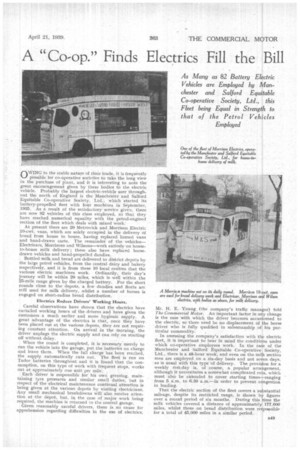A Co-op." Finds Electrics Fill the Bill
Page 85

If you've noticed an error in this article please click here to report it so we can fix it.
OwING to the stable nature of their trade, it is frequently possible for co-operative societies to take the long view in the purchase of plant, and it is interesting to note the great encouragement given by these bodies to the electric vehicle. Probably the largest electric-vehicle user throughout the north of England is the Manchester and Salford Equitable Co-operative Society, Ltd., which started its battery-propelled fleet with four machines in September, 1935, As a result of the satisfactory service given, there are now 82 vehicles of this class employed, so that they have reached numerical equality with the petrol-engined section of the fleet which deals with mixed work:
At present there are 20 Metrovick and Morrison Electric 10-cwt. vans, which are solely occupied in the delivery of bread from house to house, having replaced horsed vans and hand-drawn carts. The remainder of the vehicles-Electricars, Morrisons and Wilsons—work entirely on houseto-house milk delivery ; these also have replaced horsedrawn vehicles and hand-propelled dandies.
Bottled milk and bread are delivered to district depots by the large petrol vehicles, from the central dairy and bakery respectively, and it is from these 10 local centres that the various electric machines work. Ordinarily, their day's journey will be within 20 miles, which is well within the 25-mile range given by the charged battery. For the short rounds close to the depots, a few dandies and floats are still used for milk delivery, whilst a number of horses is engaged on short-radius bread distribution.
Ulectrics Reduce Drivers' Working Hours.
Careful observations have shown that the electrics have curtailed working hours of the drivers and have given the customers a much earlier and more hygienic supply. A great advantage of the electrics is that, once they have been placed out at the various depots, they are not requiring constant attention. On arrival in the morning, the driver unplugs the electric supply and can rely on starting off without delay, When the round is completed, it is necessary merely to run the vehicle into the garage, put the batteries on charge and leave them. When the full charge has been reached, the supply automatically cuts out. The fleet is run on Tudor batteries throughout and it is found that the consumption, on this type of work with frequent stops, works out at approximately one unit per mile.
Each driver is responsible for his own greasing, maintaining tyre pressures and similar small duties, but in respect of the electrical maintenance continual attention is being given at the various depots by visiting electricians. Any small mechanical breakdowns will also receive attention at the depot, but, in the case of major work being required, the machine is returned to the central garage.
Given reasonably careful drivers, there is no cause for apprehension regarding difficulties in the use of electrics, Mr. H. E. Young (the company's traffic manager) told The Commercial Motor: An important factor in any change is the ease with which the driver becomes accustomed to the electric, so there need be no displacement of the horse driver who is fully qualified in salesmanship of his par tictilar commodity. ,
In assessing the company's satisfaction with the electric fleet, it is important to bear ih mind the conditions under which co-operative employees work. In the case of the Manchester and Salford Equitable Co-operative Society, Ltd., there is a 48-hour week, and even on the milk section men are employed on a six-day basis and not seven days, as is usual with this type of delivery. The provision for a weekly rest-day is, of course, a popular arrangement, although it necessitates a somewhat complicated rota, which must also be atended to cover starting times—ranging from 5 a.m. to 8.30 a.m.—in order to prevent congestion in loading.
That the electric section of the fleet covers a substantial mileage, despite its restricted range, is shown by figures over a recent period of six months. During this time the milk vehicles covered a distance of approximately 177,000 miles, whilst those on bread distribution were responsible for a total of 45,000 miles in a similar period,






































































































































